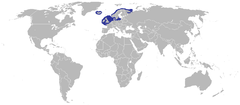- Common dab
-
Common dab 
Scientific classification Kingdom: Animalia Phylum: Chordata Class: Actinopterygii Order: Pleuronectiformes Family: Pleuronectidae Genus: Limanda Species: L. limanda Binomial name Limanda limanda
(Linnaeus, 1758)
Range of the common dab The common dab, Limanda limanda, is an edible flatfish of the family Pleuronectidae. It is a demersal fish native to shallow seas around Northern Europe, in particular the North Sea, where it lives on sandy bottoms down to depths of about 100 metres (330 ft). It can reach 40 centimetres (16 in) in length and can weigh up to 1 kilogram (2.2 lb), though most specimens grow no longer than 30 centimetres (12 in).[1][2]
Contents
Taxonomy and nomenclature
The etymology of the name dab is unclear, but the modern English use seems to originate from the Middle English dabbe.[3] It is first recorded in the late 16th century.[4]
The common dab was first named Pleuronectes limanda by Carl Linnaeus in the 1758 10th edition of Systema Naturae. It has also been moved to other genera, including Liopsetta, and is now known as Limanda limanda.[5]
Identification
The common dab has a similar appearance to both the plaice and the flounder, and similarly has both its eyes on the right-hand side of its body. The upper surface is usually pale brown in colour with scattered darker blotches and speckles, but the pectoral fins may be orange. The lateral line is marked by a distinctive semi-circular curve above the pectoral fin.[2]
Diet
The common dab's diet consists of zoobenthos organisms such as marine worms, molluscs, sand eels, amphipods, crustaceans and echinoderms.[2]
Commercial fishing
The dab is an abundant fish but is only occasionally landed as a commercial catch, sometimes as a by-catch of other targeted species.[6][7]
References
- ^ "Limanda limanda". Fishbase. 15 January 2009. Archived from the original on 3 February 2008. http://web.archive.org/web/20080203160803/http://www.fishbase.org/Summary/SpeciesSummary.php?id=695. Retrieved 2009-05-12.
- ^ a b c Picton, B.E. & Morrow, C.C. (2005). "Limanda limanda". Encyclopaedia of Marine Life of Britain and Ireland. Habitas Online. Archived from the original on 2 August 2005. http://web.archive.org/web/20050802113355/http://www.habitas.org.uk/marinelife/species.asp?item=ZG8910. Retrieved 2009-04-28.
- ^ "dab". The American Heritage Dictionary of the English Language, Fourth Edition. Houghton Mifflin Harcourt. 2006. http://dictionary1.classic.reference.com/browse/dab. Retrieved 2009-05-12.
- ^ "dab". Random House Unabridged Dictionary. Random House. 2006. http://dictionary1.classic.reference.com/browse/dab. Retrieved 2009-05-12.
- ^ "Synonyms of Limanda limanda". Fishbase. 7 May 2005. http://www.fishbase.org/Nomenclature/SynonymsList.php?ID=695&SynCode=12972&GenusName=Limanda&SpeciesName=limanda. Retrieved 2009-05-12.
- ^ Burton, Maurice; Burton, Robert (2002). "Dab". The international wildlife encyclopedia. 10. Marshall Cavendish. pp. 634–5. ISBN 9780761472667.
- ^ International Council for Exploitation of the Sea, ed (1993). North Sea quality status report 1993. Fredensborg, Denmark: Olsen and Olsen. p. 70. ISBN 9781872349077.
This Pleuronectiformes-related article is a stub. You can help Wikipedia by expanding it.
